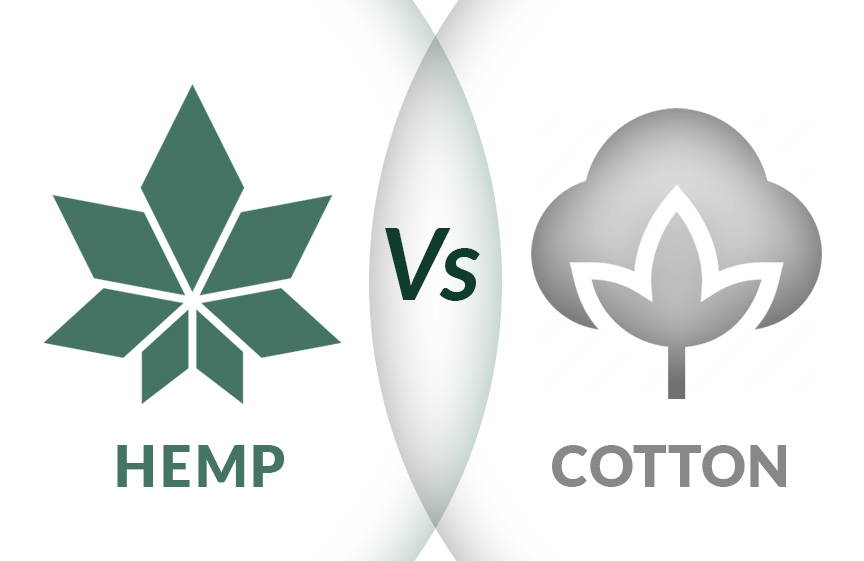
Hemp vs Cotton: 5 Reasons Why Hemp is a Better Choice
|
If you're not happy with your first pair of underwear after trying it on, let us know.
We'll send a new size or color, or give you a refund. No returns needed.

Meagan Neville
|
The concept of hemp vs cotton is a fairly new debate in the materials space. When you consider the benefits of cotton, you may think of the soft and absorbent material that has been around for generations and is known as the fabric of our lives. As for hemp, you may not think about the fabric benefits initially, but I want to bring you there, especially since hemp can save the world.
I want to share with you the various benefits of hemp and how you might be missing out on one of the most comfortable fabrics. If you didn’t know, I am happy to share with you that hemp is the most sustainable fabric. Let’s take a look and see how hemp fabric compares to cotton on a scale of some basic topics.
While hemp demands half the amount of land per 2,000 pounds of fabric textile in comparison to cotton, the latter also requires four times more water and a much longer growing period than hemp.
In today’s agricultural farming methods, cotton needs 5,280 gallons of water in order to produce 2.2 pounds of cotton this is equivalent to a single t-shirt and a pair of jeans.
Hemp on the other hand, utilizes 80 gallons of water which mainly comes from rainwater to produce an average of 2 pounds of fiber.
Additionally, with severe climate effects and current various droughts throughout the United States, it’s really not a comfortable feeling knowing that in order to produce one tee shirt and a pair of jeans, 5,280 gallons of water is needed. Tell that to agricultural farmers in California currently facing the impacts of the drought.
When purchasing hemp underwear on our website, you can directly see how your impactful purchase can save water the more you add to your cart. See it for yourself when you check out any of our hemp underwear styles, like the hemp bikini or hemp boxer briefs.
Due to being a durable rotation crop, the entire hemp crop can be put to use, as the stalk is used as fiber, the leaves and hurds can be ploughed back into the soil as fertilizer. This helps to replenish the soil fertility to help grow the next round of hemp crops.
Additionally, Hemp has a short growing season and a deep root system that allows for aeration and constant improvement of soil structure.
Cotton crops are not so kind to the soil
Cotton crops in the USA occupy 1% of the country’s farmland but use 50% of all pesticides. By using these toxic chemicals along with other fertilizers and herbicides, it severely damages the soil within the crop as well as the root systems. A farmer can continue to farm the land, but over time there will be a decrease in land quality, then resulting in lower quality conventional cotton.
Farming for cotton is not as sustainable as Cotton Inc. would like us to think. Nearly 10% of all agricultural chemicals and 25% of insecticides come from the cotton industry. These pesticides are some of the most hazardous available, and this is what ends up in the soil, rivers, and streams.
This places a direct and severe environmental impact on immediate stakeholders such as workers and families in the communities in which farming takes place.
In contrast, the hemp plant is naturally resistant to most insects and disease, basically eliminating the need for any pesticides or herbicides. Environmentally, hemp is a safer crop to grow than cotton. Overall, it looks like cotton is more of a soil-damaging crop, needing a great deal of fertilizers, herbicides and pesticides.
With industrial hemp being reintroduced into American agriculture through the 2018 Farm Bill, we are fortunate to have this miracle crop available to us. In comparing land use for hemp cultivation versus cotton cultivation, the hemp productivity levels are much greater, resulting in growth of 2,650 pounds of fiber per acre compared to 1,190 pounds of cotton fiber per acre of land. As you can see, hemp is a quickly growing and a nicely abundant crop that doesn’t max out land acreage beyond its capacity.
Today, cotton is grown in over 70 countries, all which are dry and arid environments. The crops are partially rain-fed depending on climate or drought, but the main source of water is through irrigation.
However, in areas like Georgia where hurricanes now come in during peak harvest season, up to 100,000 acres of cotton crops are lost due to climate change. As a result of the quality of the land that the crops are grown in, cotton fiber quality is decreasing along with it.
You can say that hemp fabric ages like a fine wine. The hemp fabric lasts longer and doesn’t wear out as quickly as cotton does. Hemp has three times more tensile and flexible strength than cotton, holding its shape time and again and becomes softer after each wear and wash.
Hemp is a more premium fabric. Hemp breathes really well, is moisture absorbent, offers the best sun protection while being UV protectant, and is surprisingly anti-bacterial.
On the other hand, cotton material is no match for hemp. Due to its natural softness, cotton material breaks down over time, thus as consumers, our need to purchase more cotton material increases unnecessarily over time, like with tee shirts and socks, versus hemp fabric styles.
Cotton has a natural ability to control moisture, insulate, and provide comfort for the individual wearing the fabric, and it is also hypoallergenic. However, due to heavy chemical use in production there is an overall loss of integrity in the hand and feel of conventional cotton.
You can see here in the hemp vs. cotton conversation, hemp is clearly a better choice than its counterpart. If you haven’t already, I suggest thinking about hemp next time you make a purchase. In fact, there are a number of hemp clothing brands making their mark in the apparel industry, so it should be an easy transition. From my own perspective, I think you should start with a pair of hemp underwear.
Now that you have heard both sides, are you ready to switch to hemp fabrics?
Get updates on restocks, new color and size releases, and upcoming product launches. You’ll also get a 15% discount on your first order of hemp underwear.








